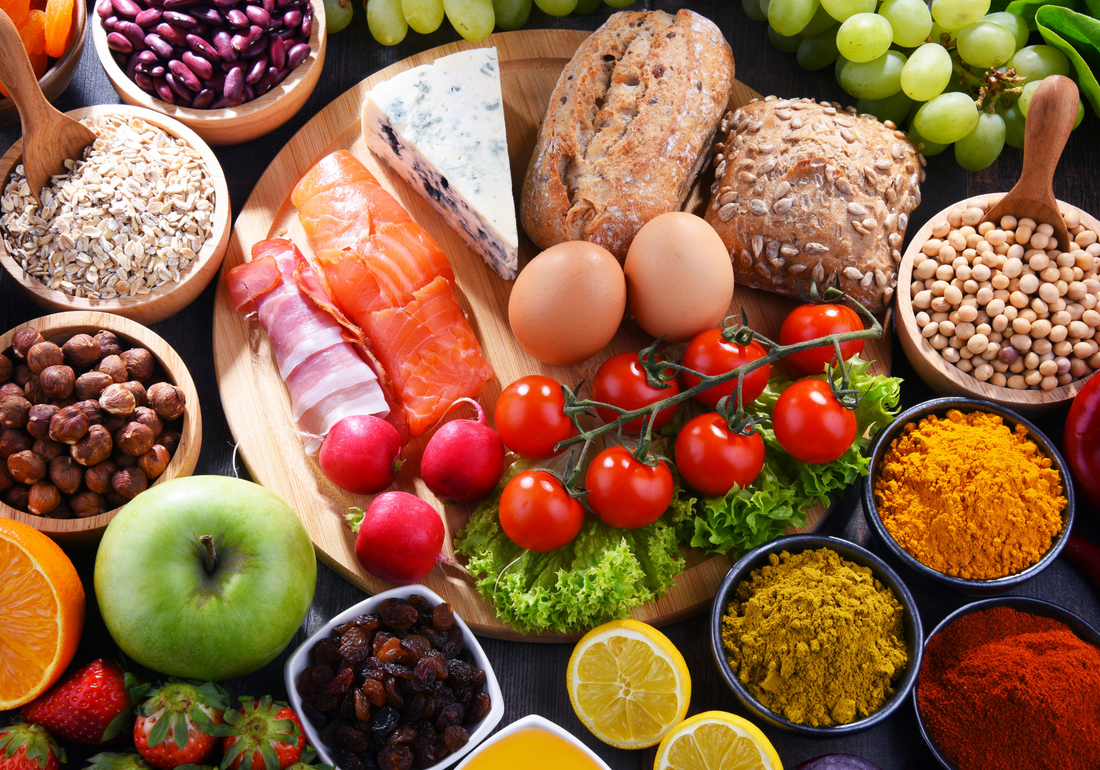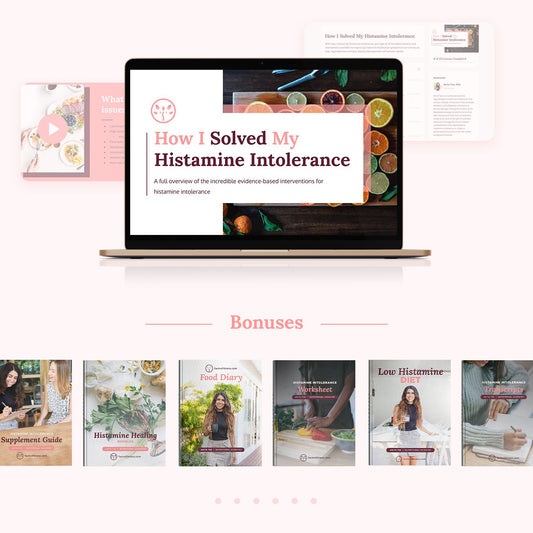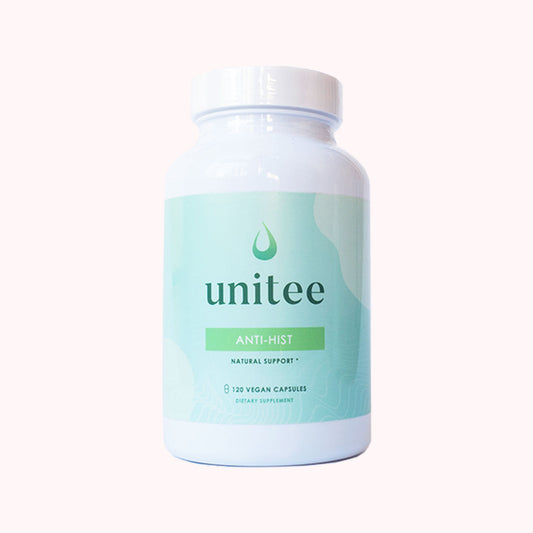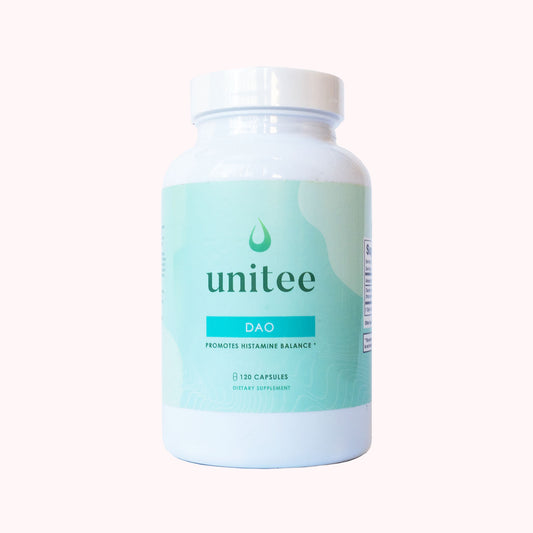So, you're struggling with histamine intolerance and don't know how to get your itching, bloating, gas, diarrhea, sleep and mood under control.
You may have tried to eat less histamine-containing foods, but probably haven't had much success because the information you've found is largely conflicting!
I feel your pain.
When I started out searching for an approach to manage my own histamine intolerance, I too didn't know where to start. But when I started looking into the research, I knew I had to get my diet under control as a first step.
And because of that, I was able to significantly reduce my symptoms while figuring out the root cause of my condition. Because it helped me so much, I dug deep into the research to ensure I could put together a comprehensive list of foods to eat on a histamine intolerance diet.
Not only is it essential for anyone who suffers from the symptoms of histamine intolerance, but it's important to give you that break in your symptoms to allow you to figure out what's really going on with your body's histamine load.
The Problem With Histamine in Food
Similar to seasonal allergies or a food allergy (1), a reaction to histamine is inflammatory. Histamine is a neurotransmitter that travels through your body in your bloodstream and helps break down food in your stomach.
But, histamine is also a part of a healthy immune system. It's an essential compound involved in the immune system's ability to bring chemicals and cells to the location your body needs it in order to fend off possible illnesses or tissue damage.
Histamine is made largely by immune cells, called mast cells. When triggered, mast cells in your tissue release histamine into the bloodstream. Histamine causes your blood vessels to become more leaky, which allows fluid to carry white blood cells to the area and locate the foreign pathogen. This foreign pathogen is a threat to your body, and histamine helps to neutralize it by supporting your immune system in what it does best.
Since histamine is something that your body naturally makes, eating high histamine foods shouldn't have negative side effects. The body is very capable of breaking histamine down and rendering it harmless.
Well, that's the case for people without histamine intolerance! For those of you who have too much histamine in their body, who have a hard time breaking down excess histamine, eating certain foods can trigger symptoms or make them even worse (2).
For these individuals, eating healthy, natural foods such as vegetables and fruits simply isn't enough. You need to be focussing on eating only those low in histamine!
Knowing which low histamine foods to fill your shopping cart with may help you manage histamine intolerance. It's a solution that can be a type of elimination diet which can help you to understand the foods affecting you the most.
Why Try a Low Histamine Diet?
1) Confirmation of Histamine Intolerance
To fully diagnose histamine intolerance, you should always work with a doctor or natural healthcare practitioner.
However, diagnosis can be difficult due to the multi-symptomatic nature of histamine intolerance. It looks like allergies with the itching eyes, runny nose and hives (3). But other systems are commonly involved where you also present with abdominal pain, cramping, bloating and gas, as well as reproductive issues and sleep problems. That's why, eliminating certain foods from your diet can help to identify histamine issues, because many of these symptoms will either disappear or become more tolerable; not just those appearing as allergy-like ones (4).
If you want to take it a step further, you can also try this at-home test for histamine intolerance.
But rest assured, trying the simple low histamine diet is a successful at-home method for understanding your health and histamine intolerance symptoms better.
2) Fast Relief from Histamine Intolerance Symptoms
Many people see symptomatic improvement within 1-2 weeks of removing high histamine foods from their diet.
This improvement also gives the body a break from the symptoms that can have a negative impact and worsen overall health, such as inflammation and stress.
As a way to combat inflammation and stress, I always recommend you implement histamine-healing therapies at the same time as trying a low histamine diet. Often these therapies are more effectively when your body is less stressed, which will come about as a result of lowering the histamine levels in the body.
3) No Guessing What to Eat on a Low Histamine Diet
My comprehensive low histamine food list removes the guesswork from following a low histamine diet. It allows you to really see how food affects you. When you stick to the low histamine list, you're likely to feel significant relief. Touch a high histamine food and your symptoms will likely flare.
As part of this list, I've also included foods that may not be directly high in histamine but ones that can destabilize mast cells or liberate histamine. Remember, mast cells make and release histamine, so we want them to remain as stable as possible to reduce the histamine load on the body. Foods that liberate histamine may also trigger gut bacteria to release histamine, so those foods have also been included in the list.
Which Low Histamine Foods List Is the Right One to Use?
The main issue with finding the right low histamine food list is that many foods can be a topic of contradiction. It’s hard to find two identical lists, leaving you a bit confused about your optimal histamine diet…
As a histamine intolerance researcher, myself and a team of scientists have put together the most comprehensive, up-to-date low histamine food list available online. We used the evidence available from various sources to ensure our list is as correct as we could make it. And we've included foods that are not only histamine-containing themselves, but can affect histamine levels in the body in different ways.
In addition, this food chart also includes all high histamine foods, so that you know exactly what to avoid. Knowing both of these lists is important; it's with this knowledge that I hope to empower you to take control of your diet and symptoms.
My goal is to give you the information you need to address histamine intolerance from all angles and experience symptomatic relief, regardless of the underlying cause.
The Histamine Intolerance Food List
I highly recommend you download my free Low Histamine Diet Guide.
Not only does it contain the full histamine intolerance foods list, but additional resources to improve symptoms, such as a food diary, special recipes and details on how to find the root cause of your histamine intolerance.
By downloading the guide you can also save the diet to your phone or print it out to have on-hand when you're at home prepping meals or out buying groceries.
| ALLOWED (Low Histamine Foods List) | RESTRICTED (High Histamine Foods List) |
| Vegetables - Allowed | Vegetables - Restricted |
|
|
| Fruits - Allowed | Fruits - Restricted |
|
|
| Meat, Poultry and Fish - Allowed | Meat, Poultry and Fish - Restricted |
|
|
| Eggs - Allowed | Eggs - Restricted |
|
|
| Fats and Oils - Allowed | Fats and Oils - Restricted |
|
|
| Spices and Herbs - Allowed | Spices and Herbs - Restricted |
|
|
| Nuts and seeds - Allowed | Nuts and seeds - Restricted |
|
|
| Legumes - Allowed | Legumes - Restricted |
|
|
| Breads and Cereals* - Allowed | Breads and Cereals* - Restricted |
|
|
| Milk and Dairy* - Allowed | Milk and Dairy* - Restricted |
|
|
| Sweeteners* - Allowed | Sweeteners* - Restricted |
|
|
|
| Other - Allowed | Other - Restricted |
|
|
|
Beverages - Allowed |
Beverages - Restricted |
|
|
* Starred food categories are not essential to include in your diet at this time, and should be consumed in minimal amounts or avoided entirely to maximize health benefits and symptom relief while following this diet.
Tips for Managing Histamine Intolerance
Managing histamine intolerance is easier than you think when you have the right info.
Here are a few tips to get started:
1) Avoid most probiotics: although probiotics are great for the gut, many strains produce histamine. If you choose to take probiotics, it's important to double check that your supplement only contains low histamine probiotic strains.
2) Find the root cause: histamine intolerance can arise from a variety of root causes such as H. pylori infection, or a genetic inability to produce DAO enzymes that breaks down histamine (5). Understanding your root cause can help you to better direct your therapies and get to the bottom of your histamine intolerance (6).
3) Get your free low histamine diet guide: in addition to the low histamine foods list, it provides resources such as a food diary, recipes and specific details about how to find the root cause of your histamine intolerance in order to improve symptoms, not just while you're following the diet, but for good!
References:
- Zhao Y, Zhang X, Jin H, Chen L, Ji J, Zhang Z. Histamine Intolerance—A Kind of Pseudoallergic Reaction. Biomolecules. 2022; 12(3):454. https://doi.org/10.3390/biom12030454
- Comas-Basté O, Sánchez-Pérez S, Veciana-Nogués MT, Latorre-Moratalla M, Vidal-Carou MdC. Histamine Intolerance: The Current State of the Art. Biomolecules. 2020; 10(8):1181. https://doi.org/10.3390/biom10081181
- Hrubisko M, Danis R, Huorka M, Wawruch M. Histamine Intolerance—The More We Know the Less We Know. A Review. Nutrients. 2021; 13(7):2228. https://doi.org/10.3390/nu13072228
- Shulpekova YO, Nechaev VM, Popova IR, Deeva TA, Kopylov AT, Malsagova KA, Kaysheva AL, Ivashkin VT. Food Intolerance: The Role of Histamine. Nutrients. 2021; 13(9):3207. https://doi.org/10.3390/nu13093207
- van Odijk J, Weisheit A, Arvidsson M, Miron N, Nwaru B, Ekerljung L. The Use of DAO as a Marker for Histamine Intolerance: Measurements and Determinants in a Large Random Population-Based Survey. Nutrients. 2023; 15(13):2887. https://doi.org/10.3390/nu15132887
- Jochum C. Histamine Intolerance: Symptoms, Diagnosis, and Beyond. Nutrients. 2024; 16(8):1219. https://doi.org/10.3390/nu16081219

Anita Tee
My name is Anita Tee. I'm a nutritional scientist who specializes in histamine intolerance. I hold a Master of Science in Personalized Nutrition and a Bachelor of Science in Human Biology and Psychology.
For the past ten years, I have used my experience in nutritional and medical health sciences to create a scientifically backed, natural approach to healthcare that relies 100% on evidence-based research.
As I previously suffered from - and overcame - histamine intolerance, my focus is to increase recognition and expand the available resources and protocols available for resolving this particular disorder. To date, I have helped over 4,000 individuals fully resolve or better manage their histamine intolerance symptoms.







